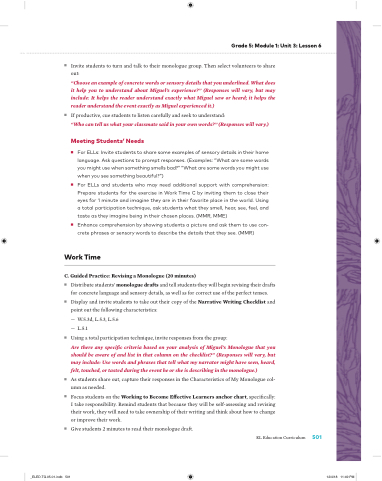Page 525 - EL Grade 5 Teacher Guide
P. 525
Grade 5: Module 1: Unit 3: Lesson 6
■ Invite students to turn and talk to their monologue group. Then select volunteers to share out:
“Choose an example of concrete words or sensory details that you underlined. What does it help you to understand about Miguel’s experience?” (Responses will vary, but may include: It helps the reader understand exactly what Miguel saw or heard; it helps the reader understand the event exactly as Miguel experienced it.)
■ If productive, cue students to listen carefully and seek to understand:
“Who can tell us what your classmate said in your own words?” (Responses will vary.)
Meeting Students’ Needs
■ For ELLs: Invite udents to share some examples of sensory details in their home language. Ask que ions to prompt responses. (Examples: “What are some words you might use when something smells bad?” “What are some words you might use when you see something beautiful?”)
■ For ELLs and udents who may need additional support with comprehension: Prepare udents for the exercise in Work Time C by inviting them to close their eyes for 1 minute and imagine they are in their favorite place in the world. Using a total participation technique, ask udents what they smell, hear, see, feel, and ta e as they imagine being in their chosen places. (MMR, MME)
■ Enhance comprehension by showing udents a picture and ask them to use con- crete phrases or sensory words to describe the details that they see. (MMR)
Work Time
C. Guided Practice: Revising a Monologue (20 minutes)
■ Distribute students’ monologue drafts and tell students they will begin revising their drafts
for concrete language and sensory details, as well as for correct use of the perfect tenses.
■ Display and invite students to take out their copy of the Narrative Writing Checklist and point out the following characteristics:
— W.5.3d, L.5.3, L.5.6
— L.5.1
■ Using a total participation technique, invite responses from the group:
Are there any speci c criteria based on your analysis of Miguel’s Monologue that you should be aware of and list in that column on the checklist?” (Responses will vary, but may include: Use words and phrases that tell what my narrator might have seen, heard, felt, touched, or tasted during the event he or she is describing in the monologue.)
■ As students share out, capture their responses in the Characteristics of My Monologue col- umn as needed.
■ Focus students on the Working to Become E ective Learners anchor chart, speci cally: I take responsibility. Remind students that because they will be self-assessing and revising their work, they will need to take ownership of their writing and think about how to change or improve their work.
■ Give students 2 minutes to read their monologue draft.
EL Education Curriculum 501
_ELED.TG.05.01.indb 501
12/4/18 11:49 PM


